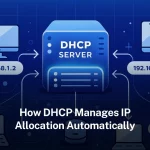IP Address Allocation Fundamentals
The allocation process ensures each device gets a distinct address. Without proper allocation, network connections would fail due to duplicate addresses. The system maintains order by following specific distribution rules.
Table of Contents
Toggle
Address assignment occurs through a structured hierarchy. Global organizations oversee the entire address pool. Regional entities receive allocations from these global authorities. Local providers then distribute addresses to end users. This layered approach prevents address hoarding. It guarantees fair distribution across different regions and network types.
Global Coordination of Address Space
The Internet Assigned Numbers Authority manages worldwide address distribution. This organization operates under ICANN’s supervision. IANA controls the complete pool of available addresses. It doesn’t assign addresses directly to end users. The authority allocates large blocks to Regional Internet Registries. These allocations follow strict policies based on demonstrated needs.
Five Regional Internet Registries handle distribution within specific areas. ARIN serves North America while RIPE NCC covers Europe. APNIC manages Asia-Pacific allocations with LACNIC handling Latin America. AFRINIC distributes addresses across the African continent. Each registry maintains detailed records of all assignments. They provide public access to this information through WHOIS services.
IPv4 Address Distribution Methods
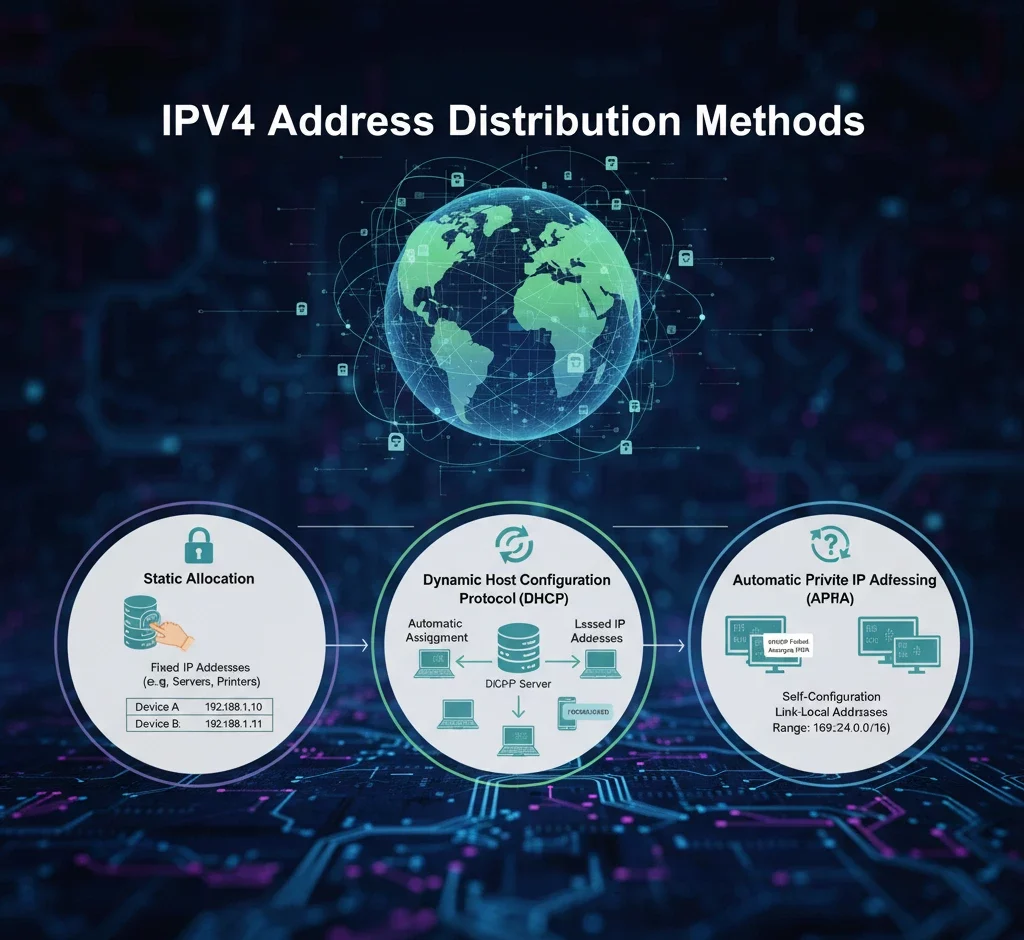
The IPv4 system offers approximately 4.3 billion possible addresses. Limited availability has made distribution increasingly strict. Organizations must provide detailed justification for requests. They must show current address usage statistics. Future growth projections must accompany all applications. This verification process ensures efficient use of remaining IPv4 space.
Regional registries have implemented special policies for IPv4 distribution. Many maintain waiting lists for address requests. Some only assign small blocks from remaining pools. Transfer markets allow organizations to buy and sell IPv4 blocks. All transfers require registry approval. IPv6 Address Assignment Differences
This abundance allows more flexible assignment policies. Organizations typically receive larger IPv6 blocks without strict justification. The generous allocations support better network designs. They eliminate address sharing requirements in most cases.
IPv6 assignment encourages early adoption and future growth. Registries assign blocks based on existing infrastructure. Most networks receive at least a /32 block initially. This approach simplifies network planning. It removes artificial constraints present in IPv4 deployments. The policies promote efficient routing through contiguous assignments.
Fixed Address Assignment Practices
Permanent address assignments serve critical network devices. Servers and network equipment use fixed addresses. This method ensures consistent access to important systems. Many applications require knowing exact device addresses. Fixed addressing simplifies network management and troubleshooting.
Managing fixed addresses requires careful organization. Network administrators must track all assignments precisely. Most networks reserve specific ranges for fixed use. Detailed records should include device information and assignment dates.
IP address management software helps maintain accurate records. Proper documentation prevents conflicts and simplifies network expansions.
Dynamic Address Assignment Systems
Most client devices use automatic address assignment. The DHCP protocol handles this process efficiently. Devices request addresses when connecting to networks. DHCP servers manage pools of available addresses. They assign addresses with configured lease durations. This method optimizes address utilization across networks.
Lease durations vary based on network requirements. Short leases work well for transient devices. Longer leases suit stable network environments. The system automatically reclaims addresses when devices disconnect. DHCP servers provide complete network configuration to clients. This includes subnet masks and default gateway information.
DHCP Server Configuration Details
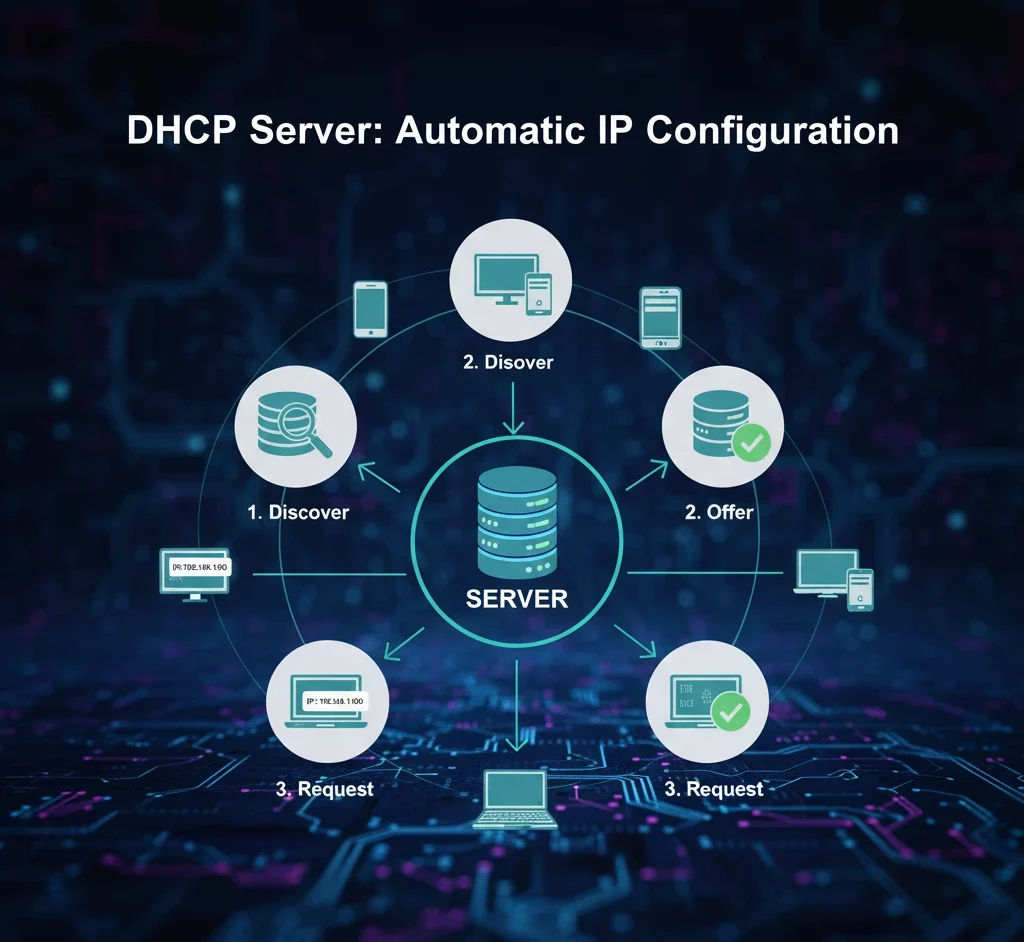
Enterprise DHCP servers offer advanced functionality. They integrate with DNS systems for automatic updates. Configuration requires careful planning of address ranges. Lease durations should match network characteristics. Most networks implement backup servers for reliability. Security features prevent unauthorized DHCP activity.
Server configurations include multiple option fields. These provide additional network parameters to clients. Time server information often gets distributed through DHCP.
Large networks may use multiple servers with split scopes. Proper DHCP configuration forms a critical network foundation. It ensures reliable connectivity for all client devices.
Private and Public Address Usage
Private addresses operate within local networks only. RFC 1918 defines these non-routable address ranges. Organizations can use them freely without registration. Network Address Translation enables internet access for private-addressed devices. This technology conserves scarce public address space.
Public addresses require proper registration and allocation. They must remain globally unique to function properly. Organizations obtain public addresses from providers or registries. These addresses enable direct internet connectivity. The assignment process prevents duplicate public addresses worldwide. Proper management maintains internet routing integrity.
Internet Service Provider Allocation
Providers receive large address blocks from registries. They distribute addresses to customers based on service plans. Residential users typically get dynamic or shared addresses. Business customers often receive static public addresses. Providers must carefully track address usage patterns.
Many providers operate automated assignment systems. These systems assign addresses based on service types. As IPv4 resources dwindle, providers implement IPv6 support. Some use carrier-grade NAT to extend IPv4 availability. Transition strategies vary among different providers.
Cloud Computing Address Management
Cloud platforms use sophisticated address management systems. They automatically assign addresses when creating resources. Virtual networks allow custom address space definitions. Providers offer various address types for different needs. Cloud environments abstract physical network constraints.
Major platforms obtain address space directly from registries. They implement advanced software-defined networking. Customers manage addresses through web interfaces and APIs. Cloud models have transformed traditional address assignment. They enable elastic address allocation matching resource demands.
Mobile Network Addressing Systems
Cellular networks use specialized assignment methods. Most carriers implement address sharing technologies. IPv6 adoption enables direct device addressing. Standards define specific methods for mobile networks. These account for device mobility and always-on connectivity.
Operators face unique assignment challenges. Their systems must handle constant device movement. Many use hierarchical assignment approaches. The growth of mobile IoT devices complicates strategies. Some operators provide public IPv6 addresses to devices. Others continue using carrier-grade NAT solutions.
Enterprise Network Address Planning
Large organizations implement comprehensive address plans. They typically divide networks into logical segments. Each segment gets its own address range. This improves security through access controls. It simplifies troubleshooting by creating clear boundaries.
Many enterprises use IP address management software. These tools automate assignment tracking. Large organizations may request independent address space. Proper planning includes growth provisions. Regular audits verify address usage matches documentation. Recovery policies reclaim unused addresses.
Data Center Address Allocation
Modern data centers require meticulous address planning. Virtualization increases address needs significantly. Software-defined networking adds complexity. Data centers must coordinate physical and virtual addressing. High-density deployments demand efficient allocation methods.
Many facilities use automation for address assignments. These systems integrate with management databases. Security models may require unique addresses per workload. Containerized applications need special address planning. Proper allocation supports reliable data center operations.
IoT Deployment Addressing
IoT implementations create massive address demands. Many use IPv6 to avoid exhaustion concerns. Some implement special assignment methods for IoT devices. Industrial systems often need fixed addressing. Security concerns influence assignment strategies.
Network segmentation isolates IoT devices from other systems. Some implementations use private addressing for internal components. Short DHCP leases prevent address exhaustion. Proper allocation supports IoT functionality while maintaining security. The growth of IoT drives IPv6 adoption significantly.
IPv4 to IPv6 Transition Strategies
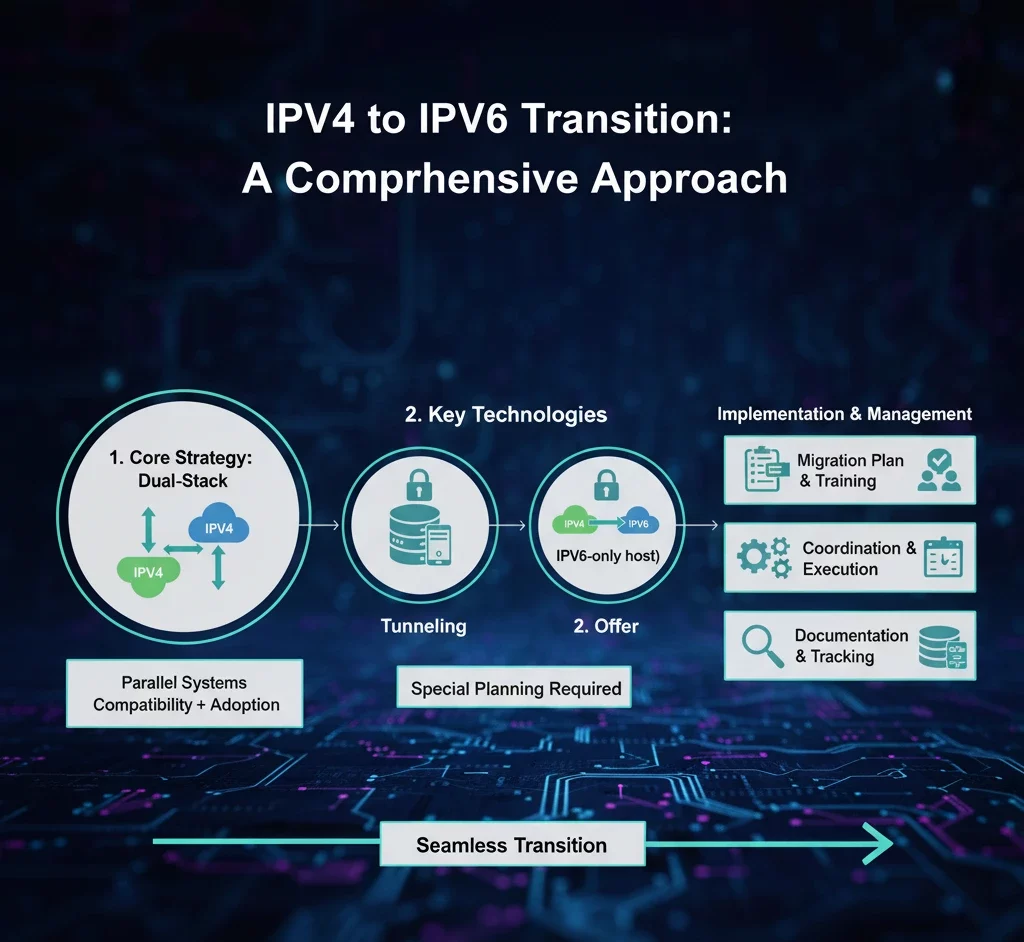
Most networks implement dual-stack operation during transition. This maintains compatibility while enabling IPv6 adoption. Assignment systems must manage both address types. The migration involves running parallel systems temporarily. Different transition methods require specific approaches.
Tunneling and translation technologies need special planning. Organizations should develop detailed migration plans. Staff training ensures proper management during transition. The process requires careful coordination across teams. Documentation should track all address assignments during migration.
Most networks implement dual-stack operation during transition. This maintains compatibility while enabling IPv6 adoption. Assignment systems must manage both address types. The migration involves running parallel systems temporarily. Different transition methods require specific approaches.
Tunneling and translation technologies need special planning. Organizations should develop detailed migration plans. Staff training ensures proper management during transition. The process requires careful coordination across teams. Documentation should track all address assignments during migration.
IP Address Management Tools
Specialized software helps manage address assignments. These systems provide centralized tracking. Advanced features include conflict detection and DNS integration. Many solutions offer reporting capabilities. Enterprise systems support complete lifecycle management.
Cloud-based options manage hybrid environments. The tools help optimize address usage. They simplify expansion and renumbering projects. Proper tool selection depends on network size and complexity. Implementation requires careful planning and configuration.
Common Allocation Problems
Address conflicts cause connectivity issues. These often result from duplicate assignments. Proper management practices prevent most conflicts. Network scans identify unauthorized static assignments. Address exhaustion plagues IPv4 networks. Careful planning with growth buffers helps.
NAT technology conserves public addresses. IPv6 networks face different sizing challenges. Legacy systems sometimes cause assignment issues. Network documentation helps troubleshoot problems.
Security Considerations
Assignment practices impact network security. Fixed addresses present higher risks. Regular changes reduce exposure. Network segmentation contains potential breaches. DHCP servers require protection. Monitoring detects rogue server activity.
Management systems should integrate with security tools. Proper assignment supports defense strategies. Security policies must cover address management. Logs should record all assignment changes. These measures maintain network integrity.
Emerging Trends
5G networks need new assignment approaches. Edge computing requires distributed management. IPv6 adoption changes traditional paradigms. AI applications optimize assignment patterns. Blockchain solutions have been proposed.
Innovations promise more efficient systems. Technologies must adapt to evolving needs. Networks require flexible assignment strategies. The field continues evolving rapidly. Professionals must stay informed about developments.
Future Challenges
IPv4 exhaustion continues causing issues. Complex workarounds or IPv6 adoption are needed. Hybrid environments demand new approaches. Smart devices test system scalability. Quantum networking may require new architectures.
Professionals must adapt strategies continuously. Stable operations require ongoing adjustments. The field will keep evolving. Addressing systems must remain flexible. Proper planning prepares networks for future needs.
IP Address Allocation in Specialized Environments
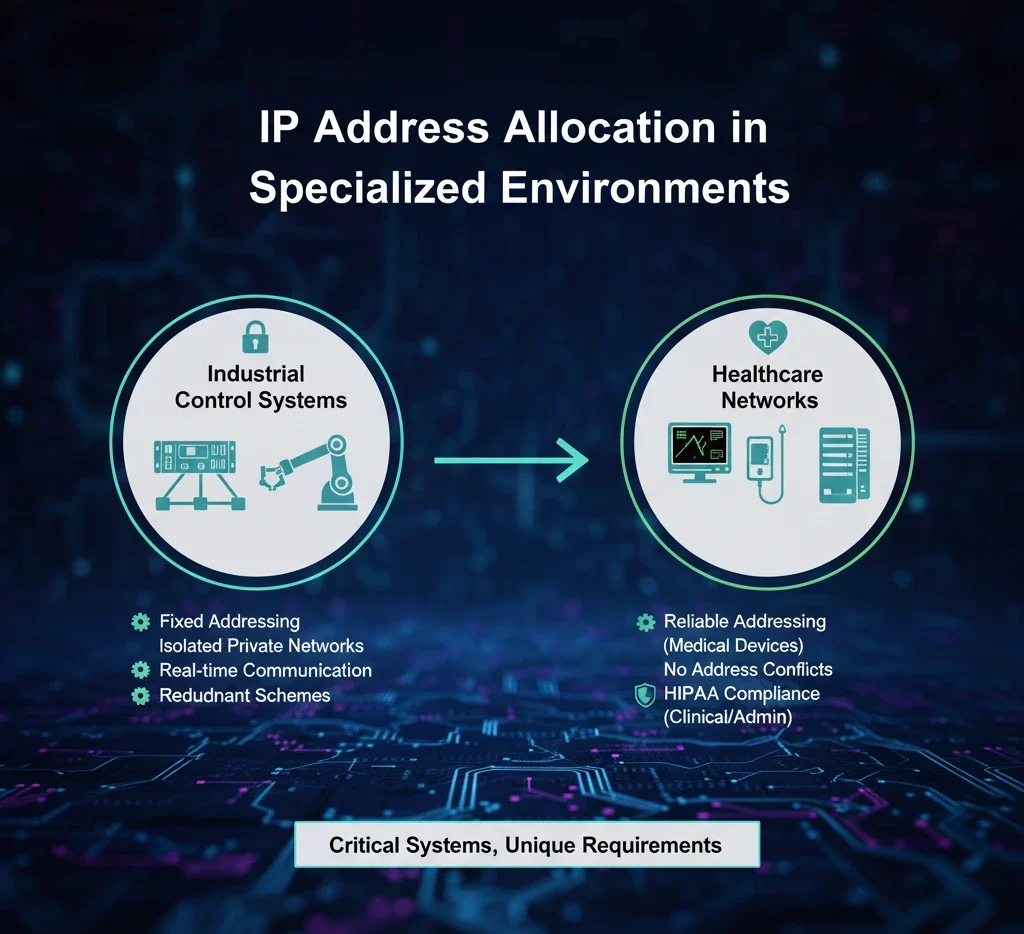
Industrial control systems require unique address allocation approaches. Manufacturing plants use specialized protocols with fixed addressing needs. Programmable logic controllers demand consistent IP assignments. These systems often operate on isolated networks with private address space. The allocation must account for real-time communication requirements. Redundant systems frequently mirror addressing schemes for failover capabilities.
Healthcare networks present distinct allocation challenges. Medical devices require reliable addressing for continuous operation. Patient monitoring systems cannot tolerate address conflicts. HIPAA regulations influence address management practices. Separate networks often handle clinical systems and administrative functions. Downtime can have life-threatening consequences in these environments.
Educational Institution Allocation Practices
Universities manage complex address allocation needs. Campus networks serve diverse user groups with different requirements. Student devices connect and disconnect frequently throughout the day. Research projects may need special address allocations for experimental setups. Wireless networks experience high address turnover in lecture halls.
Academic networks typically implement multiple subnets. Faculty, staff, and students each receive dedicated address ranges. Guest networks accommodate visitor access without compromising security. Library systems and research labs often need static assignments. The allocation system must scale during peak enrollment periods.
Government Network Allocation Methods
Public sector networks emphasize security in address allocation. Many agencies implement strict assignment policies. Detailed audit trails track all address changes. Some organizations use proprietary addressing schemes for added protection. Inter-agency connections require careful coordination of address space.
Shared services need compatible addressing across departments. Transition plans must account for bureaucratic processes. Compliance requirements dictate specific documentation practices. Government networks often operate under higher security classifications. These factors influence address allocation decisions.
Financial Sector Allocation Requirements
Banks and trading platforms have stringent addressing needs. Low-latency networks demand optimized address assignments. Transaction systems require consistent addressing for reliable operation. Security controls include IP-based restrictions for sensitive systems. Fraud detection monitors address patterns for suspicious activity.
Disaster recovery plans include detailed addressing documentation. Financial networks often use proprietary protocols with specific requirements. The allocation system must support high availability architectures. Regular audits verify compliance with financial regulations.
Smart City Addressing Infrastructure
Municipal networks connect diverse urban systems. Traffic management requires reliable addressing for signal coordination. Utility networks need consistent addressing for grid monitoring. Public safety systems depend on stable address assignments. The growth of IoT devices increases address demands.
Network segmentation isolates critical infrastructure systems. Centralized management provides oversight across departments. The allocation system must accommodate future expansion. Security considerations influence address assignment strategies.
Allocation for E-Commerce Platforms
Online businesses depend on reliable addressing. Load balancers distribute traffic using virtual IP addresses. Content delivery networks employ geographic IP assignment. These systems require careful address planning. The allocation must support peak shopping periods.
Security measures include IP-based rate limiting. Fraud prevention systems analyze address patterns. Temporary blocks prevent brute force attacks. The address management system must integrate with e-commerce platforms.
Entertainment Industry Allocation Needs
Media companies have specialized addressing requirements. Content delivery networks require optimized address assignments. Streaming platforms need reliable addressing for quality service. Broadcast systems use consistent addressing for equipment control.
The allocation system must support high-bandwidth applications. Network segmentation separates production and administrative traffic. Address management integrates with digital rights management systems.
FAQ
1. What are the fundamental steps in IP address allocation?
IP address allocation begins with global coordination, where large blocks of addresses are managed by a top-level authority and passed down through regional registries to local providers. Then within networks, addresses are assigned via fixed/static methods or dynamically (for example via DHCP). Networks must also divide up addresses logically (subnets), decide between public vs private space, plan for usage (IoT, mobile, enterprise, cloud), and consider transition from IPv4 to IPv6.
2. How do IPv4 and IPv6 differ in allocation approaches?
Because the older IPv4 address space is nearly exhausted, stricter controls apply: organisations often have to justify needs, show usage statistics, accept smaller blocks, and participate in transfer markets.
The newer IPv6 space has far more addresses, so the emphasis shifts toward planning for growth, running dual-stack systems (IPv4 + IPv6), and transitioning existing networks. The allocation process remains similar but the constraints and long-term planning differ.
3. What allocation considerations come into play for specialised environments (e.g., mobile, IoT, data centres)?
In mobile networks, devices move and connect/disconnect frequently, so dynamic addressing, carrier-grade NAT or IPv6 direct addressing are common. In IoT, large numbers of devices and small form factors mean assignment methods must scale, often use private space, and management/segmentation becomes crucial.
Data centres face high density, virtualization and containerization—so they must map physical and virtual address space, automate allocation, and support rapid growth or change.
4. What are common problems in IP allocation and how can they be mitigated?
Common issues include IP conflicts (duplicate addresses), address exhaustion (especially IPv4), undocumented static assignments, and poor transition planning to IPv6. Mitigations include: regular audits of address usage; reclaiming unused addresses; using IP Address Management (IPAM) tools to track assignments; careful planning of subnets; adopting IPv6 proactively; and applying good security practices around DHCP/static allocation.
5. What best practices should organisations follow for efficient and secure IP address allocation?
- Adopt a clear hierarchical address plan (e.g., by geography, business function, device type).
- Use dynamic allocation for non-critical devices, reserve static/public addresses for key systems.
- Use IPAM tools to track assignments, usage, growth trends and automate where possible.
- Plan and implement IPv6 support early rather than delaying.
- Document everything: assignment records, lease times, ownership. Perform audits.
- Segment networks (IoT, data centre, guest, production) to control exposures and growth.
- Periodically review, reclaim and optimise address space to avoid waste and conflicts.
Trusted IPv4 Leasing for Business Growth
Get enterprise-grade IPv4 space quickly, with seamless deployment and end-to-end management.
Related Blogs
Related Posts
-
IPv6 address allocation: what you need to know
IPv6 allocation rules ensure fair global distribution and help organisations prepare their networks for long-term…
-
How Mismanagement of IP Allocation Impacts Network Security
The Roots of Poor IP Allocation and Its Security Risks Every device on a network…
-
How DHCP manages IP allocation automatically
DHCP uses a four-step process (Discover, Offer, Request, Acknowledge) to lease IPs automatically from a…
-
IP Allocation Challenges in Developing Regions
Introduction to the Idea of IP Allocation An IP address is what allows your device…
-
IP Allocation Best Practices for Enterprises
An essential yet commonly disregarded, crucial component that influences network security and efficient operation is…


